Enabling Smart City Resilience Through Center of Gravity Analysis
Victor R. Morris
Introduction
The “Joint Operating Environment 2035” assesses the center of gravity (COG) for the world’s population is shifting from the developed world to the developing world. The security challenges present in dense urban areas include adversary convergence and unassimilated communities. Humanity is developing into an urban species, therefore the Smart City (SC) system of systems becomes the primary center of gravity for relevant populations. A SC is one that utilizes information and communication technology (ICT) to enable citizens and meet their demands. Moreover, a SC involves the community by incentivizing participation, encouraging ownership, and improving the lives of residents. Interdependent populations cope with environmental stressors and nonlinear escalation through a resilient city system. A high fitness landscape is the objective of a resilient SC system.
Urban and global trends present a variety of critical factors contributing to center of gravity analysis and resilience assessments. The increase of urbanization makes instability and conflict within dense population centers a real and emerging possibility. 1 Major wars of attrition between 2001 and 2017 turned millions of civilians into refugees and stateless populations 2. Enduring resilience is critical to minimizing the effects of system perturbations or “butterfly effects” and developing effective coping strategies.
The proposed SC Resilience Framework employs 19th century Prussian General Carl von Clausewitz’s Center of Gravity concept elucidated through SC critical factors analysis. The current definition of COG uses systems theory and refers to the primary entity that inherently possesses the critical capabilities to achieve the objective 3.
The goal of the framework is to enable SC system resilience. The design processes employed linear COG analysis methods, then non-linear approaches to modify critical factors and transform critical vulnerabilities. It includes a holistic and customized approach to planning, which not only shapes, but allows for shaping by the changing environment to enable resilience.
Accurately assessing and repairing critical vulnerabilities that exacerbate system perturbations is critical for a strategy oriented towards resilient and “smart” living. The strategy is applied to a chaotic and multi-domain environment. The overall aim of this article is to confirm COG concept utility by identifying the primary COG, which possesses the critical capabilities to influence non-linear human and environmental system perturbations. Resilience occurs when relevant systems re-order to become less vulnerable to shocks.
Understanding Nonlinear Science, Dynamical Systems and Resilience
A systems perspective to understanding interdependent yet diverse environments is contained in decades of academic and military assessments (Figure 1). Revised COG analysis draws on systems theory and uses it to link critical factors to the center of gravity. Critical factors consist of critical capabilities, critical requirements and critical vulnerabilities.
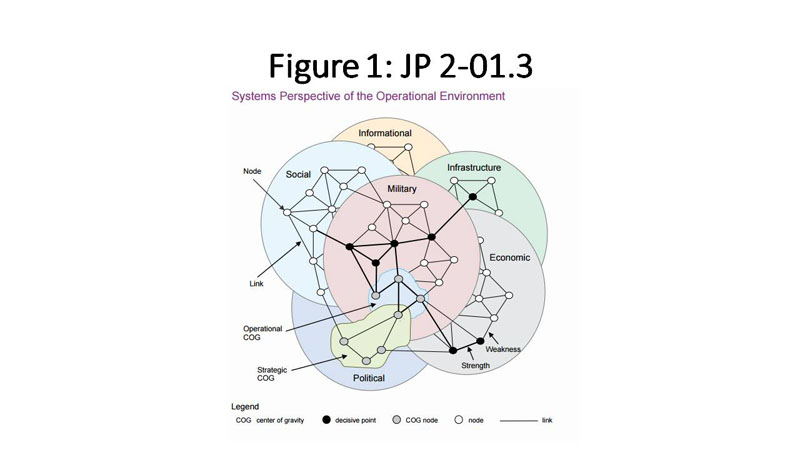
The majority of the systems present in the world are nonlinear in nature. Nonlinear science has origins in mathematics, general systems theory, cybernetics, fractal geometry and meteorology 4. Network centric warfare borrowed concepts from chaos theory to describe an international system prone to exponential changes or “butterfly effect”. Chaos theory describes certain nonlinear dynamical systems as having a sensitivity to changes in initial conditions. Nonlinear means that due to feedback or multiplicative effects between the components, the whole becomes something greater than the mere sum of its individual parts. Dynamical means the system changes over time 5.
Dr. Mark Galeotti uses the term nonlinear war in his book “Hybrid War or Gibridnaya Voina Getting Russia’s non-linear military challenge right”. He states there are two separate kinds of intertwined nonlinear war. One aspect involves political destabilization and the other a hope of dividing, demoralizing and distracting the West. These aspects overlap heavily as two sides of a wider form of nonlinear war 6.
Nonlinear system resilience initially decreases the formation of malign networks. If malign networks are already present in the system, resilience compels such networks to adopt incentive structures leading toward a high fitness landscape. In evolutionary biology, fitness or adaptive landscapes represent the relationship between individual and reproductive success. High fitness is typically represented by mountain ranges (figure 1). An evolving population climbs uphill until a local optimum is reached.
Resilience is a term used in ecology, social sciences, engineering and the military. In all cases, the term emphasizes the ability of a system to cope with disturbances, adapt, and re-organize into a stable state. Coping refers to degrees of success and increased stability when presented with disturbances. Similarly, the term thriving, whether physical or psychological, reflects decreased reactivity to stressors, faster recovery or consistently higher level of functioning. After an adverse system perturbation, at least four potential consequences occur (Figure 2). Conceptions of thriving involve desensitization and enhanced recovery potential. Recent approaches involve urban resilience to chronic stresses and acute shocks. Some examples of chronic stresses and acute shocks are high unemployment, natural disasters and terrorist attacks. The urban system is a system of systems and requires a coherent and comprehensive approach to reach an adaptive state. A March 2017 RAND assessment discusses a counter-terrorism strategy centered on the historical resilience of American society. The author asserts understanding how terrorism works fosters a psychologically more resilient and less vulnerable mindset 7. This is one specific example of coping, re-organizing and adapting to stressors.
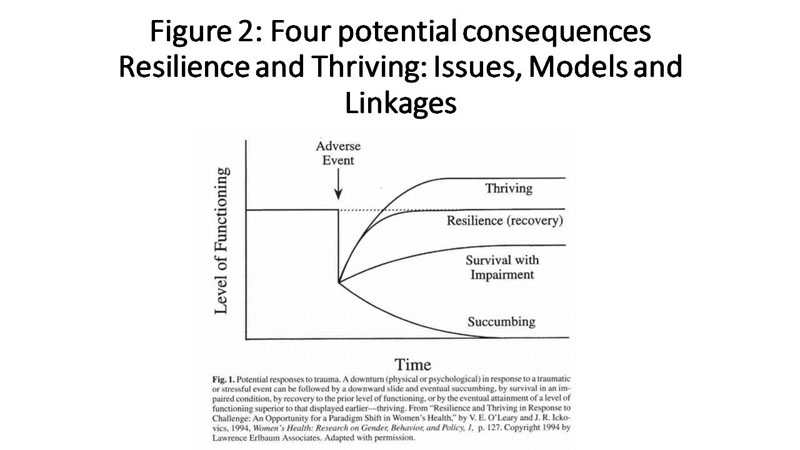
In the dynamic systems view, the overall goal of urban resilience is to move the city system from a local minimum, to a location that is closer to optimal. To reach this state, reorganization of what currently exists must occur. The term “resilience” in this case reflects the process of establishing resilient behavior to reach a thriving status and optimal position within the fitness landscape (Figure 3).
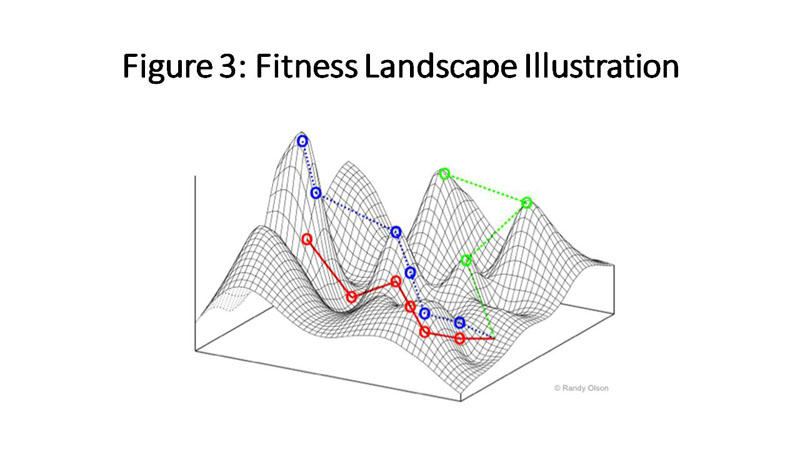
This article uses the term “complex evolving system”, in lieu of the more widespread “complex adaptive system” based on the influence of human interactions. Complex evolving systems “work together to create new order and coherence, to sustain the organization and to ensure its survival, particularly when its environment or social ecosystem is changing fast.” 8 Cities exhibit a high number of complex systems characteristics (Figure 4).
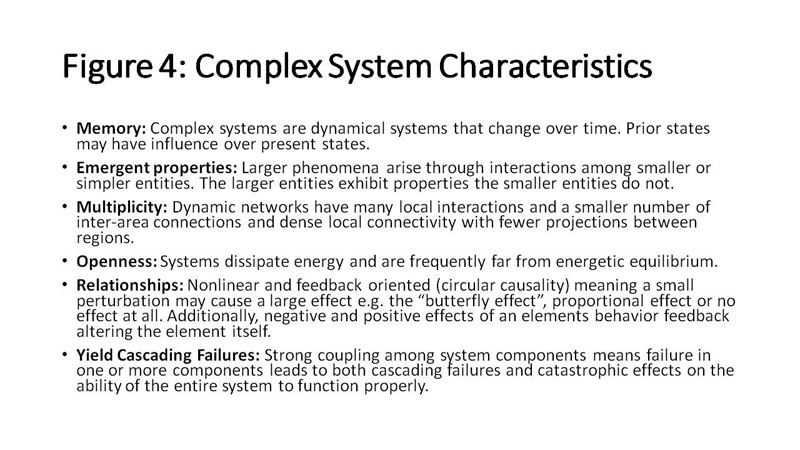
City as a Complex Evolving System
A 2015 Small Wars Journal article entitled “City as a System Analytical Framework: A Structured Analytical Approach to Understanding and Acting in Urban Environments” identifies cities of all sizes present a variety of challenges. These challenges include information saturation, unique terrain, and diversity of controllers 9 .The same article identifies “Environmental Centers of Gravity” or E-COGs as the nodes and/or flows most critical to a problem system. This article assesses environmental and cognitive considerations as being related to the primary COG. Data-rich online social media platforms are “Cognitive COGs” or C-COGs which overlap domains and city systems. The “weaponization of information” necessitates cognitive resilience within the information environment as well.
This section uses of variety of cities as short case studies to highlight the above challenges and aids in the development of resilience solutions. These challenges or factors personalize in the physical, cyberspace and information environments by residents who are part of groups, organizations and populations. The aforementioned article describes unique terrain with the concept of “edgelessness’ meaning cities no longer end at their administrative edges or political boundaries. Concepts of interdependence and resilience have no physical boundary and depend on the mutual support of all relevant systems and subsystems.
Another crucial factor is the influence of human populations, as the center of gravity for information activities, unique or contested terrain, and diversity of controllers. Ukraine, Kiev, and the War in Donbass illustrates a fusion of the four above factors resulting in bifurcation, or split from mono-stable to multi-stable states. Kiev is more resilient than the eastern oblasts, which demonstrates multiplicity. As the hub, Kiev has more dense interactions, but fewer axons or connections to the Donbass region.
Recent assessments by the General Staff of the Russian Federation’s Armed Forces concluded “the protest potential of the population”10 has a high probability to turn a once thriving state into a “web of chaos”. These assessments are based on lessons learned from the Arab Spring. This theory personifies non-linear escalation and fluctuating fitness landscapes, but also justifies consolidation of control in Russia and Turkey. Moscow and Istanbul are the 11th and 7th largest cities proper in the world by population 11. Their leaders exhibit an aversion to “western influence” through so-called “political warfare” resulting in regime change.
One Russian Federation assessments finds color revolutions and “exporting security” results in violence, poverty, social disasters, and total disregard for human rights. Western intervention is the system perturbation that exacerbated the existing grievances or perturbations in Ukraine. This phenomenon escalated non-linearly into chaotic states 12. The post 9/11 Global Transaction Strategy (GTS) included the concept of exporting security as preventive war strategy to remove rogue regimes who threaten globalization 13.
In summary, when perturbations affect the totality of city challenges it results in unpredictable and chaotic states. This is a lesson learned from on-going operations in Afghanistan and Iraq, which has resulted in co-evolution of complex systems and physically emerging states. The extremist proto-state referred to as “Daesh” exhibits complex system characteristics and city centric challenges. Ramadi, Mosul, Aleppo, al-Raqqa and Dabiq are cities of varying sizes and have proven to be centers of gravity for various populations, organizations, groups and ideologies. The city as a center of gravity is not limited to the specific regions and has implications for international systems as well. This phenomenon involves 21st century irregular warfare as a state of persistent conflict or perpetual war. Pre-emptive use of military force in conjunction with stateless, disenfranchised, and identity driven populations account for dense interactions. These interactions often result in system(s) perturbations that lead to the escalating nonlinearity and chaos.
The city system is the wielder of a high fitness landscape. A large part of resilience involves coping with conflict enabling conditions before they escalate into chaos and total war. Those conditions include internal and external political interference and environmental stressors. Resilience is not limited to the human domain and is enabled by regulated autonomous systems too.
COG Analysis Methods Overview and Application
What disturbances destabilize complex evolving systems and what enables resilience to destabilization and chaos?
The answer lies in the SC COG analysis for enabling relevant populations. In 1996, Dr. Joe Strange developed a concept to link factors to the center of gravity. His critical factors concept became United States Joint Doctrine in 2002 14 .COG analysis consists of critical factors analysis, which includes critical capabilities, requirements and vulnerabilities of the COG. This section applies three existing COG analysis methods and one emergent method to the SC system to demonstrate holistic application and evolution of the concept. This application expands the enemy centric focus, similar to recent Australian Defense Force’s approaches involving addressing non-adversarial threats preventing mission accomplishment 15.The Australian Defense Forces have also modified the definition of the COG focused on capability to achieve a desired end state or specific objective.
A modern definition of COG uses logic to define what a COG is or is not. Logically: A (primary entity) + B (capability to achieve the objective) = COG 16.
The COG is not a source of power as previously defined; it is the possessor and wielder of that power. The SC COG uses or consumes supporting resources to accomplish the objective; a tangible physical agent that must perform the actions. Relevant organizations and actors who draw power from the city have interrelated requirements. These include controlling information, terrain and populations and result in the multi-layering and overlapping of critical factors. Next, this method takes concepts from mathematics like exploring system behavior and stability. Similar to mathematical methods COG and critical factors analysis reveals hidden structure and patterns in underlying dynamics that may not be apparent. Defeat, stability and response options also develop from this type of analysis. Promoting or “targeting” resilience is intangible, but targeting individuals, organizations, and systems compelled to enable resilience is not.
COG Analysis Method 1: Forward or Linear
“Let’s Fix or Kill the Center of Gravity Concept” by Colonel (Retired) Dale C. Eikmeir describes COG analysis within Dr. Strange’s framework of three critical factors, which can be targets for indirect attacks 17. The below factors are analyzed in a linear way, which involves identifying the COG and associated critical factors.
- Critical capability: primary abilities that merit a COG, identified in the context of a given scenario.
- Critical requirement: essential conditions, resources, and means for a critical capability.
- Critical vulnerability: critical requirements or components thereof that are deficient or vulnerable to neutralization, interdiction, or attack in a manner achieving decisive results.
COG Analysis Method 2: Inside Out
The second method applied conducts COG analysis from the inside out 18. According to this method, beginning with the COG is erroneous because of a non-definitive method to determine it. There is also no safeguard against picking the wrong COG. A re-iteration that the process does not have to occur in a sequential manner emphasizes an earlier assessment by Col Eikmeir to identify objectives, then critical factors. Identifying the objective and “working to the right of the critical capabilities” (CC-CR-CV) is the “inside out method”.
COG Analysis Method 3: Hybrid Threat 6 Step
The third approach applies a new method for hybrid threat COG analysis 19. It accounts for the amorphous nature of hybrid threat adversaries. The six-step analytical process outlined below was verified against the center of gravity analysis for a SC as an adaptive system of systems.
- Identify Observed Modalities
- Identify Adversary’s Assessed Objectives and Limitations—Ends
- Identify the Critical Capabilities—Ways
- Identify the COG—Modality of Principal Use
- Identify the Critical Requirements—Means
- Identify the Critical Vulnerabilities
Combination COG Analysis Method and Framework Development
The following two-part method emerged from a variety of critical factors analyses of a known COG and objectives. First, the linear method based on familiarity, then an inside-out and nonlinear approach by identifying factors and re-aligning them to the appropriate category (Figures 5 and 6).
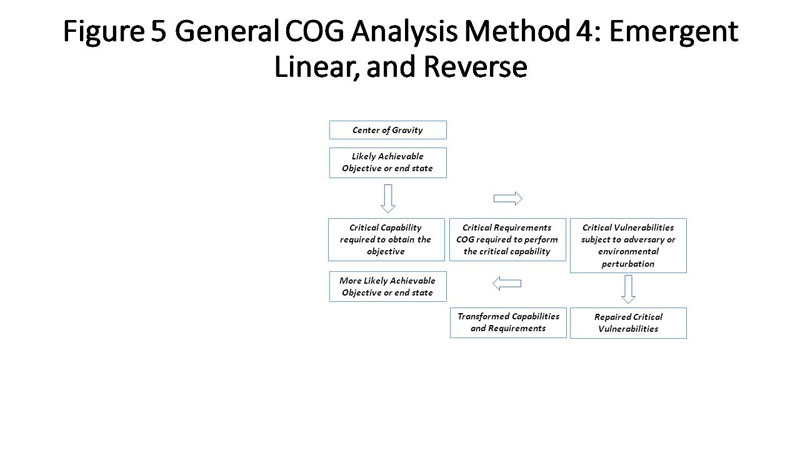
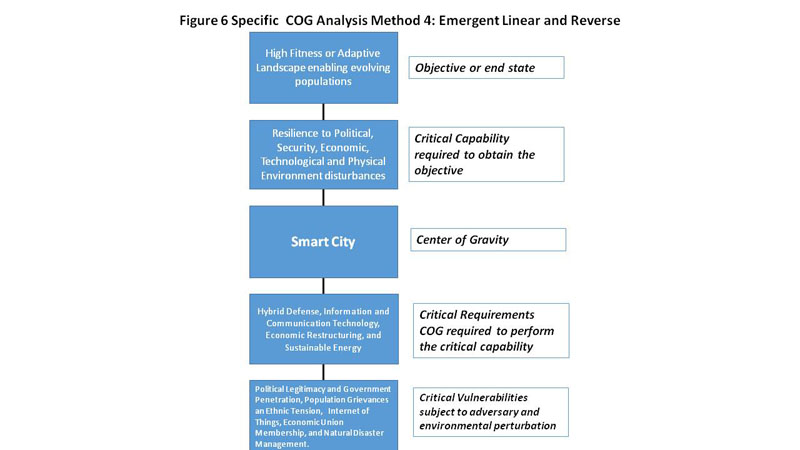
The detailed list of critical vulnerabilities became the focal point for repairing and resilience framework development. Once again, a SC is one that utilizes information and communication technology (ICT) to meet the demands of the market and incentive structures. Incentive structures were highlighted for repair, as things that motivate an individual to perform an action or promote cooperation or competition within a larger structure. ICT-generated data guides the incentive structures, relevant functions and connects objects and environments to form the Internet of Things (IoT) as a SC and resilience enabler.
Key concepts involving unified communications and communities are crucial to making critical vulnerabilities resilient to environmental disturbances. The below findings are the focal points for part two of the framework development.
- The main effort or modality of principle use to establish a high 21st century fitness landscape for human and intelligent agent populations is the urban system of systems.
- Urban or City COGs link to national and international knowledge economy and high fitness landscape objectives.
- Urban COGs establish the foundation for the identification and selection of incentive structures.
- Critical Factors to SC resilience objectives are: state sovereignty and government penetration, super empowered groups and coalitions, legitimate use of physical force (monopoly on violence), economic integration, and globally connected high-speed communications.
Whole of Society Resilience Analytical Framework (Ways, Means and Ends)
Critical Capabilities or Ways (Verbs or Ability to): RECIPE
- Restructure economic and energy sectors through growth, innovation cooperation and free trade
- Enable government transparency, penetration, and population access to essential services
- Connect, secure and standardize ICT and large data set architecture with embedded fail safes, and alternate function systems (primary, alternate, contingency and emergency)
- Inter-organize institutions, maker culture, and spaces to optimize national security and rule of law
- Place make, enable e-participation and deliver narratives through mutual aid networks in the information environment
- Extend smart living through artificial general intelligence (AGI) 20 life cycle management and artificial neural networks
Critical Requirements or Means (Nouns):
-
Urban Informatics (people, ideas and technology)
- Government
- Personal
- Network of sensors
-
Urban Design (built environment)
- Super empowered administrative network
- Global trade network access and creation of resources
- Mobility and transportation (e.g. Barcelona superblocks)
- Agriculture
- Sustainable, renewable, and smart energy
- Heat effects mitigation
-
Urban Protection (multi-domain)
- Information and critical infrastructure protection
- Enhanced medical and rehabilitation services and outreach (substance and mental health)
- Infectious disease tracking, prediction and outbreak containment
- Ethical surveillance and policing
- Enhanced multinational civil-military forward engagement and positioning
- Complex Intelligence Preparation of the Battlefield/Battlespace with agent based models (ABMs) 21
- Target centric warfare as “war control”
- Cyber security and deterrence, human in the loop contingencies and electromagnetic spectrum protection
- Improved collective, artificial and all-source intelligence approaches and sharing
- Decentralized mission command systems and combined arms integration
- Joint and combined arms forces and sustainment
- Multination counter-proliferation policies
- Flood, earthquake and storm effects mitigation and response
-
Urban Partnerships (inter-organization and multi-national)
- Public, private, and maker cooperation
- Local, national and international resilience shaping
- Digital inclusion of all demographics
Smart Living in Smart Cities (Ends)
- Community awareness and education
- Mass collaboration
- High fitness landscape
- Inclusive incentive structures
- Quality of life and well-being management
Conclusion
In conclusion, hybrid and parallel resilience is critical to minimizing disturbances and developing effective coping strategies in the contexts of future conflict and adaptability. Identifying and transforming critical vulnerabilities that exacerbate system perturbations facilitates a strategy oriented towards resilient or “smart” living. Organizational and technological adaptation are ways to reduce the effects of instability and complexity in dynamic systems. The SC Resilience Framework facilitates the objective of the smart city system to preform actions enabling human and intelligent agent populations towards high fitness. Smart Cities + Smart Power = Smart Living.
End Notes and References
- Gian Gentile, David E. Johnson, Lisa Saum-Manning, Raphael S. Cohen, Shara Williams, Carrie Lee, Michael Shurkin, Brenna Allen, Sarah Soliman, James L. Doty III, “Reimagining the Character of Urban Operations for the U.S. Army”, The RAND Corporation (2017).
- Anthony H. Cordesman, “Afghanistan, Iraq, Syria, and Yemen: Is Decisive Force an Option?” CSIS (4 April 2017). Accessed on 20 April 2017 at: https://csis-prod.s3.amazonaws.com/s3fspublic/publication/170404_War_Use_Decisive_Force.pdf?365r7YdicB5HDUHnEox7c9M_4N5swDKh .
- COL (Retired) Dale C. Eikmeier “Let’s Fix or Kill the Center of Gravity Concept”, Joint Force Quarterly 83 (1 October 2016).
- Dr. Sean T. Lawson “Nonlinear Science and Warfare” Chaos, complexity and the U.S. military in the information age” (2014).
- Geoff Boeing “Visual Analysis of Nonlinear Dynamical Systems: Chaos, Fractals, Self-Similarity and the Limits of Prediction” (7 September 2016). Accessed on 15 April 2017: http://www.mdpi.com/2079-8954/4/4/37/htm.
- Dr. Mark Galeotti “Hybrid War or Gibridnaya Voina Getting Russia’s non-linear military challenge right”, Mayak Intelligence (2016).
- Brian Michael Jenkins “Taking the 'Terror' Out of Terrorism Requires Outsmarting Fear”, The RAND Blog (16 March 2017).
- Dr. Eve Mitleton-Kelly, “Complex Systems and Evolutionary Perspectives on Organizations” The Application of Complexity Theory to Organizations. London School of Economics, Chapter 2 Accessed on 17 April 2017: https://www.researchgate.net/profile/Eve_Mitleton-Kelly/publication/38959106_Complex_Systems_And_Evolutionary_Perspectives_Of_Organisations_The_Application_of/links/00b4952939abe2f538000000.pdf?origin=publication_list.
- Mark Lomedico and Elizabeth M. Bartels, City As a System Analytical Framework: A Structured Analytical Approach to Understanding and Acting in Urban Environments, Small Wars Journal (4 August 2015).
- General of the Army Valery Gerasimov, Chief of the General Staff of the Russian Federation Armed Forces “The Value of Science Is in the Foresight” English Version, Military Review (January-February 2016).
- “List of cities proper by population” accessed on 26 April at: https://en.wikipedia.org/wiki/List_of_cities_proper_by_population.
- “Comments by Russian President Vladimir Putin to the UN General Assembly”, Military Review (January-February 2016). Editor’s note: This is the official transcript of a speech given by Russian President Vladimir Putin 28 September 2015 to the UN General Assembly as released by the office of the Russian president.
- Dr. Sean T. Lawson “Nonlinear Science and Warfare” Chaos, complexity and the U.S. military in the information age” (2014).
- LTCs Jan L. Rueschhoff and Jonathan P. Dunne “ Centers of Gravity from the Inside Out”, Joint Force Quarterly, Issue 60 (1st Quarter 2011).
- Timothy R. Heath, “Chinese Political and Military Thinking Regarding Taiwan and the East and South China Seas”, The RAND Corporation (13 April 2017).
- COL (Retired) Dale C. Eikmeier “Let’s Fix or Kill the Center of Gravity Concept”, Joint Force Quarterly 83, 4th Quarter 2016 (1 October 2016).
- COL (Retired) Dale C. Eikmeier “Let’s Fix or Kill the Center of Gravity Concept”, Joint Force Quarterly 83, 4th Quarter 2016 (1 October 2016).
- LTCs Jan L. Rueschhoff and Jonathan P. Dunne “ Centers of Gravity from the Inside Out”, Joint Force Quarterly, Issue 60 (1st Quarter 2011).
- LTC Michael D. Reilly “Hybrid Threat COG Analysis: Taking a Fresh Look at ISIL”, Joint Force Quarterly, Issue 84 (1st Quarter 2017).\
- Luke Muehlhauser “What is AGI”, MIRI, 11 August 2013.
- Majors Tom Pike and Eddie Brown, “Complex IPB,” Small Wars Journal (24 March 2016).
About the Author(s)
Comments
July 2011: TED Talk
Physicist Geoffrey West has found that simple, mathematical laws govern the properties of cities -- that wealth, crime rate, walking speed and many other aspects of a city can be deduced from a single number: the city's population.
In this mind-bending talk from TEDGlobal he shows how it works and how similar laws hold for organisms and corporations.
"Every week from now (2011) until 2050, over one million people are being added to our cities".
Topics:
-Exponential increase of urbanisation and expansion
-Dual nature of cities
-Scientific theory of cities
-Predictive frameworks
-Resilience of cities
-Sublinear attributes
-Non-linear power scaling
-Networks
-Cities attract the good, bad and ugly
-Universality and human influence
-Running out of resources and cycles of innovation
-Faster innovation (which I assess correlates to Smart Cities...)
https://www.ted.com/talks/geoffrey_west_the_surprising_math_of_cities_a…
May 2017:
https://www.amazon.com/Scale-Universal-Innovation-Sustainability-Organi…
Haven't read it yet.
'Smart cities' and smart societies have existed long before the arrival of information technology (ICT), so the point of much of this article is lost on me.
Such places, notably in the developing world, but including too many places in the Western democracies, often have far more capable providers of public and private goods than the state. I would contend that the arrival of ICT has made them more effective than the state.
Is there really 'the primary entity' in many cities, not a multiplicity of powerful entities and a good part of which are NOT obvious to outsiders. Simple communications and established trust networks WORK. Why should such entities adopt our ICT and the likelihood of becoming vulnerable to the state and others?
Unfortunately because American forces do not take into consideration the situation in the USA it has a decided effect in how smart city's are modeled as if we can only understand them in foreign contexts, in fact its here. Whether it is Little Dominican in the Washington Heights, or a woman preaching Jihad in Chicago,Center of Gravity? Is written of as a hybrid that were derived from contexts like Iraq and Afghanistan that have tribal explanations. The model here might have use inn those contexts, However, it seems impracticable for understanding the issue in the USA suggesting some anthropological lag that creates its own unbridgeable gaps.
Center of Gravity? Hybrids are better when explaining the collapse of national cohesion and rule of law by drug gangs and religious or other fanaticism. Coping? I thought we already were.
